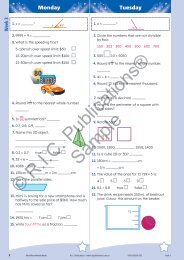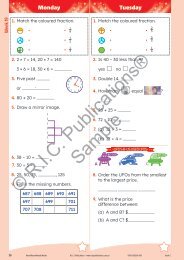20771_Problem_solving_Year_6_Background_information_resources
Create successful ePaper yourself
Turn your PDF publications into a flip-book with our unique Google optimized e-Paper software.
INTRODUCTION<br />
<strong>Problem</strong><br />
Student is unable to make any<br />
attempt at a solution.<br />
Student has no means of linking<br />
the situation to the implicit<br />
mathematical meaning.<br />
Students uses an inappropriate<br />
operation.<br />
Student is unable to translate<br />
a problem into a more familiar<br />
process.<br />
Likely causes<br />
• lack of interest<br />
• feels overwhelmed<br />
• cannot think of how to start to answer question<br />
• needs to reconsider complexity of steps and <strong>information</strong><br />
• needs to create diagram or use materials<br />
• needs to consider separate parts of question, then bring parts<br />
together<br />
• misled by word cues or numbers<br />
• has underdeveloped concepts<br />
• uses rote procedures rather than real understanding<br />
• cannot see interactions between operations<br />
• lack of understanding means he/she unable to reverse situations<br />
• data may need to be used in an order not evident in the problem<br />
statement or in an order contrary to that in which it is presented<br />
• try a succession of different operations if the first<br />
ones attempted do not yield a (likely) result<br />
• focus on keywords for an indication of what might<br />
be done without considering their significance<br />
within the problem as a whole<br />
• read problems quickly and cursorily to locate the<br />
numbers to be used<br />
• use the first available word cue to suggest the<br />
operation that might be needed.<br />
Other possible difficulties result from a focus on being<br />
quick, which leads to:<br />
• no attempt to assess the reasonableness of an<br />
answer<br />
• little perseverance if an answer is not obtained<br />
using the first approach tried<br />
• not being able to access strategies to which they<br />
have been introduced.<br />
When the approaches to problem processing<br />
developed in this series are followed and the specific<br />
suggestions for <strong>solving</strong> particular problems or types<br />
of problems are discussed with students, these<br />
difficulties can be minimised, if not entirely avoided.<br />
Analysing the problem before starting leads to an<br />
understanding of the problem’s meanings. The cycle<br />
of steps within the model means that nothing is tried<br />
before the intent of the problem is clear and the<br />
means to a solution have been considered. Focussing<br />
on a problem’s meanings, and discussing what needs<br />
to be done, builds perseverance. Making sense of the<br />
steps that need to be followed and any answers that<br />
result are central to the problem-<strong>solving</strong> process that<br />
is developed. These difficulties are unlikely among<br />
those who have built up an understanding of this way<br />
of thinking.<br />
A final comment<br />
If an approach to problem-<strong>solving</strong> can be built up using<br />
the ideas developed here and the problems in the<br />
investigations on the pages that follow, students will<br />
develop a way of thinking about and with mathematics<br />
that will allow them to readily solve problems and<br />
generalise from what they already know to understand<br />
new mathematical ideas. They will engage with these<br />
emerging mathematical conceptions from their very<br />
beginnings, be prepared to debate and discuss their<br />
own ideas, and develop attitudes that will allow them<br />
to tackle new problems and topics. Mathematics can<br />
then be a subject that is readily engaged with, and<br />
become one in which the student feels in control,<br />
instead of one in which many rules devoid of meaning<br />
have to be memorised and (hopefully) applied at the<br />
right time and place. This enthusiasm for learning and<br />
the ability to think mathematically will then lead to a<br />
search for meaning in new situations and processes<br />
that will allow mathematical ideas to be used across<br />
a range of applications in school and everyday life.<br />
R.I.C. Publications ® www.ricpublications.com.au <strong>Problem</strong>-<strong>solving</strong> in mathematics<br />
xix


















